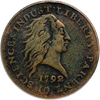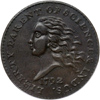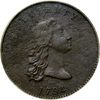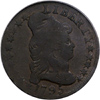
|
Sale 8
Coin and Currency Auction
| Lot |
Photo |
Description |
Realized |
Lot 151 |
 |
1792 Cent. Copper or Fusible Alloy. Reeded edge. Judd-2, Pollock-2, Rarity-7. . J-2. PCGS graded VG-10. We don't know if this is a fusible alloy or a copper cent, not that it matters very much. This coin should be tested by an expert in order to properly identify if it is one of the fusible alloy pieces. The idea behind the fusible alloy was Henry Voigt's. He decided that by placing a small amount of silver (like the silver center cents) and mixing it into the copper to make a cent, the size could be greatly reduced. To strike a coin worth one cent of copper, the coin would have been four times as large as this coin. Note the size and weight of the 1792 Birch Cents, and just imagine a few of those clunkers jangling about your pockets. Voigt was onto a good idea, but it wouldn't fully develop until 1856 when the large cents were reduced in size to the Flying Eagles, then reduced again in 1864 to French bronze pieces, and finally in 1982 to a small copper coated zinc planchet in use today. Trouble with Voigt's mixing the silver with the copper, is that you couldn't tell if there was any silver, and the value would then be brought into question. The last thing the new government needed was a scandal, especially trying to pass inflated money (which had frequently happened elsewhere) off on the unsuspecting public. A silver and copper alloy combination would have to wait.
One of the better examples of this extremely important coin known, this 1792 pattern issue was likely struck in December of 1792 at the Philadelphia Mint. It had been proposed to strike three type of cents, and Thomas Jefferson himself wrote to George Washington with information about this early coinage as follows:
"Th. Jefferson has the honor to send the President two cents made on Voigt's plan of putting a silver plug worth three quarters of a cent into a copper worth one quarter of a cent."
"Mr. Rittenhouse is about to make a few by mixing the same plug by fusion with the same quantity of copper. He will then make of copper alone of the same size and lastly he will make the real cent as ordered by Congress, four times as big. Specimens of these several ways of making the cent may now be delivered to the Committee of Congress now having the subject before them."
Thus, the 1792 pattern cents were made in three ways, the famous silver center cents, the fusible alloy with the silver and copper mixed together (or just plain copper), and regular large copper cents. This is the fusible alloy type, possibly only copper, one can't tell without an expert in metallurgy to confirm the presence of the proper amount of silver in the copper planchet.
Sharply struck and well preserved, unlike several others which are corroded or simply not appealing in grade. Clean surfaces and well struck, with familiar dark olive patina in the fields, lighter coppery shades on the devices. Struck with the reverse die rotated 180 degrees from later coinage, so you turn the coin over side to side, instead of top to bottom, and all known specimens show this die alignment. The edge has a raised reed at the center of the edge, although it is hard to see in the PCGS holder. There are some trivial pin scratches near the bust tip and others in the hair, and a very minor edge tap is noted above the second T of STATES. Overall, this coin is pleasant, the surface roughness is familiar to any copper collector, and not too bad as such things go, and the coin has a wonderful appearance to the eye. The date and devices are all strong, and the only weakness is on the ON of ONE at the central reverse.
A list of the known specimens is taken from the Norweb Collection, 11/88:3393:
1). National Collection
2). Norweb, second finest known
3). Garrett: 2348, ex Maris, Seavey (1873)
4). Lauder:234, Bowers and Ruddy's Rare Coin Review, #53 (This Coin)
5). ANA Museum, ex Paramount's Century Sale, 1965:50; Pine Tree 2-21-75:59
6). Harmer-Rooke 11-69; to a private collection, Good to Very Good, porous
7). Lohr (1961); River Oaks, Bowers and Ruddy, 1976:909; Stack's 1-14-87:476, Good, porous
8). Crosby, Plate X, 12, the Appleton-MHS coin, now untraced.
An exciting and historic pattern to own, and certain to be one of the highlights of any collection it graces.
Estimated Value $35,000-UP.
View details and enlarged photos
| Realized
$57,500 |
Lot 152 |
 |
1792 Copper Disme. Reeded edge. Judd-10, Pollock-11, High Rarity-6. . J-10. PCGS graded EF-45. Here is one of the most desirable of the 1792 pattern issues. Approximately 15 are known in all grades of this important trial piece. This is one of the finer ones known, behind the stunning example from the Garrett collection. Better than EF coin from the Norweb sale, and similar to the Stack's 1976 ANA sale specimen. It doesn't appear to be the Crosby plate coin either from our check of available reference works.
Medium to dark brown in color and very well preserved. The surfaces show only the slightest trace of porosity, mostly in the lettering. Quickly identifiable by a minor planchet lamination near the bust tip through the B of LIBERTY, and this feature will allow the next owner to quickly trace the specimen from the few known in this grade from the roster below. No circulation marks or other problems, clearly this coin was cherished soon after it was struck and carefully preserved by generations of numismatists. Only 3 pieces graded by PCGS, one the MS-65, the other two both EF-45. No others reported by that service.
Here is a list of those known, taken from the Bowers and Merena Norweb Sale, November 1988, lot 3391:
1). Garrett: 2352 as Choice AU, now graded Specimen MS-65 by PCGS
2). Norweb, 11-88:3391 as EF, prior to that Ex. Ellsworth
3). Lauder: 237 as "AU", ex Jackman:224
4). Stack's ANA 1976:131. "EF" Ex: NERCA, November 1975:383
5). Byron Reed Collection "Fine"
6). Robison: 968 "VF", Ex: Park:203, Stack's June 1973:879, weakly struck lower right obverse
7). Stack's January 1987:515 "AG", Bowers and Ruddy, November 1976:937
8). Crosby Plate X, 18, EF? (probably not this coin)
9). Bushnell:1761, EF?
10). National Collection, ex Mint "AU."
11). Eric P. Newman Collection
12). Ten Eyck:566-A, "VF"
13). Jess Peters, ANA, 1973:1088, "AU-Unc."
14). Another, whereabouts unknown
Of the above, we checked several but were unable to trace this specimen from our available library reference material (time is also a factor too, of course). It could be the Lauder coin, or the Bushnell, maybe even the Ten Eyck or Jess Peters piece noted, or even one not even listed above.
The story of the 1792 pattern issues is filled with mystery and guesswork. We know the founding fathers were very interested in the founding of the Philadelphia Mint, and Washington was a frequent visitor. The foundation for our coinage had been laid by Robert Morris, Superintendent of Finance in the 1780s. The results of these early efforts resulted in the Nova Constellation coinage and pattern issues. The establishment of a mint would have to wait a few more years. In 1790 Congress instructed Alexander Hamilton, the Secretary of the Treasury, to prepare a plan to establish a Mint. In July of 1791 a report was submitted to Congress by Hamilton, and on March 3, 1792 Washington approved a joint resolution of Congress to establish a mint. The original legislation, prior to the April 2 passage read as follows:
"Upon each of the said coins there shall be an impression or representation of the head of the President of the United States for the time being, with an inscription which shall express the initial or first letter of the Christian or first name and his surname at length, the succession of the presidency numerically, and the year of the coinage; the reverse of the gold and silver coins to bear…an eagle with the inscription UNITED STATES OF AMERICA"
Well, President Washington did not find favor with this (see the 1791 and 1792 contract coinage patterns elsewhere in this sale for examples!). Washington did not want to be represented on our coinage, and had the section changed to read "…an impression emblematic of Liberty, and the year of coinage…" dropping the President from coinage.
While the Mint was still an idea, a New Jersey sawmaker named John Harper used his Philadelphia facilities and small coining press to make contract coinage. Research has confirmed that the first half dimes, using George Washington's own silver dinnerware, were coined in his cellar located at the corner of Sixth and Cherry Streets, Philadelphia, in early 1792.
On July 1, 1792 David Rittenhouse was selected by Washington to be the first Director of the Mint, A lot was purchased on Seventh Street in Philadelphia, and the lot was cleared. A cornerstone was laid July 31, 1792 by Rittenhouse. By September 7, 1792 operations began. On September 11, six pounds of copper were purchased for coinage. Coinage presses ordered from England arrived September 21, 1792. Congress had required the onerous bond of $10,000 for the Mint employees in order for them to coin either silver or gold. The cost of the bond could not be met initially, and for this reason, no silver or gold was coined in 1792-93 at the Philadelphia Mint. Washington referred to the Half Dismes in his fourth annual address on November 6, 1792.
The first copper coins struck at the Mint were in December of 1792, coiner Henry Voigt's account includes the notation "Struck off a few pieces of copper coin" under the date of December 18, 1792. Perhaps this reference is to this coin, or the various cents produced, silver center, fusible alloy, or large cents of 1792 to show the powers that be. Decades later, when the original Mint building was demolished, Frank H. Stewart found two planchets for making the 1792 silver center cents, thus verifying that these were almost certainly struck at the Mint.
As to this 1792 Disme, the dies are thought to have been engraved by Joseph Wright, the famed engraver of the 1793 half cent and Liberty Cap cent. Wright died of Yellow Fever in September 1793, just after completing a few dies. Wright's artistic talents far exceeded those of Robert Scot, who was hired to replace him as the defacto chief engraver. Our thanks to the cataloguers of the Norweb collection for the above information, and for further reading on the subject, see Breen's Encyclopedia, U.S. Mint and Coinage by Taxay, and Frank Stewart's History of the United States Mint.
Estimated Value $35,000-UP.
View details and enlarged photos
| Realized
$109,250 |
Lot 153 |
 |
1794 Pattern Silver Dollar, struck in copper, no stars, lettered edge. J-18, P-25, Unique! . J-18. PCGS graded VF-20. Judd-18, Pollock-25. Unique! This unique copper dollar is almost certainly the very first dollar coin struck at the Philadelphia Mint, and its importance can't be overstated. The obverse die of this coin was apparently used to coin only this piece. For most of its history, collectors thought that after this piece was coined, the stars were added to the obverse die and the balance of the 1794 silver dollars struck came from this die pairing. Research by Andrew W. Pollock III finally demonstrated in 1989 that the obverse die did not later have the stars added, but that an entirely new die was engraved for 1794 silver dollars with stars.
It is virtually certain that this coin was a pattern issue reviewed by all Mint and Federal officials. It is very similar to the pattern 1794 half dime, also with no obverse stars (Judd-14) which is also unique. In the 1792 pattern issues, the motto LIBERTY PARENT OF SCIENCE AND INDUSTRY was used on the obverse. This motto dropped in 1794 and not used again. Without the motto, the fields were left open, and the head of Liberty is centered between the word LIBERTY and the date 1794 below. After viewing this coin, and probably the 1794 no stars pattern half dime, the decision to add stars to future dies was made. No doubt Mint officials decided the stars would further protect the coin and increase its longevity in circulation. We note the cheeks on Liberty are very full, not unlike the Sheldon-24 large cent of 1794, but not quite as dramatic on this coin as seen on the large cent. Perhaps the two dies were made by the same engraver?
The obverse die differs from the 1794 with stars as follows: the 4 on the no stars obverse is placed over the center of a dentil, while on the with stars pieces the 4 is not perfectly centered over a dentil. The placement of the digits in the date are also slightly different on this coin than the later with stars variety. We also note that the hub used to produced this die lacks certain details, mostly on the back of the curls on Liberty. On later 1795 silver dollars, which use this same hub (Liberty's head) on the obverse, the hair curls tips, lettering, date, and stars would be added to the die. Note in particular that the curl tip (usually third from the bottom) has not been engraved on this 1794 no stars die, but a third curl tip is always added on the with stars 1794 dollar obverse and all 1795 flowing hair dies later. We would guess the engraver simply used the obverse hub to make the die and didn't complete the finishing details of lengthening curls. Also, note the size, direction and length of this normally hand engraved curl tip is diagnostic on later 1795 silver dollar obverse varieties and used to tell the dies apart. Using a master hub produces identical dies, except for added details, like the lettering placement, curls added etc… The reverse die is the same used to produce all known 1794 silver dollars. Curiously, the reverse die was not used later in 1795, although the die showed no signs of breaking or wear on the few 1794 dollars produced.
The physical characteristics include a deep dark chocolate brown color, the surfaces show a fine layer of porosity, with some small deep pits and general roughness on much of the surface. The reverse has more porosity than the obverse. Diagnostics are all present, and the coin is not unlike most large cents of the era. The edge lettering is sharp, and can be seen despite the PCGS holder insert, if examined carefully. There are no unsightly bangs or bumps, the rims are very choice, and the coin has a pleasant appearance overall. A couple of faint scratches can be seen on the obverse and reverse, but a strong glass is needed. The dollar is the central monetary unit of coinage in this country. This coin is apparently the first and only example to survive from this die pairing, with a pedigree that includes several of the most famous collectors of the past two centuries. A more important opportunity to purchase any coin simply can not be imagined.
What makes this coin so important is that it is likely the very first "silver" dollar struck at the Mint. It is obviously a die trial piece, struck in copper to test the dies, coining equipment, and to receive approval from the officials. As noted, apparently this met with disfavor, as a new obverse die was engraved and used to coin the small number of 1794 silver dollars later that year. It is likely that this very coin was inspected by President Washington, as well as countless other government and Mint officials. Washington was very interested in the progress at the Philadelphia Mint, and would no doubt have been involved in approving the new silver dollar.
What is curious is that this coin somehow was lost, and the rumor that it was given to President Washington as a memento has generally been disproven. Research by the late Jack Collins indicates that this coin may have shown up when the first Philadelphia Mint building was torn down around 1833 when the new Philadelphia Mint began service. This coin is first reported in the collection of John W. Haseltine, which is the time the silver center cents (1792) found their way into the Mint Collection in Philadelphia. As this coin is porous, it may well have been buried for a time, or at least in a damp environment (Philadelphia certainly qualifies for that!). This coin is next known in the Robert Coulton Davis collection, Davis was the special pharmacist who used his authority to obtain large amounts of laudanum for Mint employees, from whom he obtained many coins for his collection! When Davis sold his collection in 1890, this coin was purchased by Harlan T. Smith and David Proskey, who then sold it to Lorin Parmelee. Next it went to George D. Woodside via the Parmelee Sale of 1890, Woodside sold it via Smith and Proskey again to William H. Woodin. Wooden sold it after a few years to Waldo Newcomer. At some point later, Dr. J. Hewitt Judd bought the coin where it was included in his famous book on Pattern coins. Next it turns up in a Sotheby's Sale in London in 1973, where Ed Milas purchased it and sold it to a Delaware Collector. The coin next crossed the block in the 1977 Getty Sale by Bowers and Ruddy, then later in the sale by Bowers and Merena of Dr. Nelson Page Aspen (ANA Sale) of 1989 lot 741. The coin was then sold to the current consignor.
While this coin is not as beautiful as the gem 1794 with stars copper dollar in the Smithsonian Institution, this coin does have one advantage, it was struck first! This may not be the most valuable coin in the sale, but it will always be one of the most important we have ever sold. A museum piece that still resides in private hands, at least for now.
Estimated Value $75,000-UP.
View details and enlarged photos
| Realized
$92,000 |
Lot 154 |
 |
1795 Pattern Half Eagle. Copper, reeded edge. Judd-23, Pollock-38, One of Two Known! . J-23. PCGS graded VG-10. An extremely rare pattern issue struck from the regular mint dies, known as die pairing Breen-3-D, Miller-5. The reverse has the curious second S over D in STATES. History tells us that only two copper trial patterns are known of 1795 half eagles. The other one is defaced, presumably at the Philadelphia Mint to stop if from being gilded and passed as a half eagle. Obviously, that piece would not be as desirable with the dents defacing the coin. One must conjecture that this was a pocket piece, it has smooth even wear with all of Liberty's head sharp and defined, although a few stars are worn into the rim, similar on the reverse, but the central portion of the eagle's breast is a bit weak, along with some of the peripheral letters, especially STATE. For a copper coin, the color and surfaces are choice, none of the usual pitting or corrosion is present, unlike most copper coins of this era. For additional identification, there are two minor scratches below the last A of AMERICA.
One must speculate that this coin was the pocket piece of someone special. We could make the usual statement that this was probably George Washington's personal example, along with the thousands of other worn coins frequently "traced" as his pocket pieces (as Marty Oghigian used to say "Washington had mighty large pockets" whenever someone claimed to have yet another George Washington pocket piece discovery). We certainly don't know who's coin it was 206 years ago, but someone treasured it for many years, and carried it as a memento. Logic dictates that it was someone working in the Mint, or a very influential politician that was well connected with the Mint. Perhaps we will never know, but this is a coin that is overflowing with history, and because of its moderate grade, will likely realize a price that will put it within the reach of many serious collectors, the lucky winner of which will certainly treasure this coin for many years to come, as it has been treasured in the past.
Walter Breen speculates that this die was probably made by the bumbling Robert Scot, the Mint's engraver at the time. Around the periphery several of the dentils extend well into the fields, far beyond the normal placement. Breen speculates that this was Scot slipping with his engraving tool as he fumbled his way into numismatic history. This is likely as Scot was the probable choice for making such important dies, no one else being available at the time. The dies were probably prepared in May of 1795, and this may have been one of the first struck. There is evidence of an undertype from a host coin, likely a large cent as a half cent would have been too narrow to be the planchet, while a large cent could be cut down and rolled to the correct size. When examining this coin with a glass, note the undertype line that runs up from Liberty's nose on the half eagle into her forehead and hair, and another tell tail remnant is located along her upper drapery into her hair. On the reverse, there are other traces of undertype near the branch and into the eagle. Careful study will resolve this puzzle, and it will prove enticing for numismatists to ponder what the source of the planchet was. A most thoroughly enjoyable piece of Americana.
Estimated Value $7,000-UP.
No provenance information included.
View details and enlarged photos
| Realized
$13,800 |
|
|